Difficulty learning nonsense words may indicate a child’s high risk of dyslexia

Researchers at Aalto University and the Niilo Mäki Institute have used neuroimaging to pinpoint where the brain activates – or doesn’t activate – among children identified as having a high risk of dyslexia. Magnetoencephalography (MEG) has rarely been used to study the reading disorder in children.
The brain study was carried out at Aalto University by measuring brain activity with MEG, which measures the weak magnetic fields arising from electrical activity in the brain, over a period of two days. Earlier studies have shown that difficulties in processing sounds may be partly responsible for dyslexia, and that these challenges may relate to the left auditory cortex which processes language.
During the study, the children listened to nonsensical four-syllable words from a loudspeaker and were asked to repeat them. The researchers then asked the children if they had heard the word before.
‘The words were nonsense words that really don’t mean anything. We wanted to see how the kids learned to create memories of new words. We noticed that children at a high risk of dyslexia also have deficiencies in learning new words based on hearing them. Their memories of new words were not very precise, and they weren’t capable of differentiating the made-up words from each other. This is an indication of a broader difficulty in processing words in the brain, which makes learning to read more difficult as well’, says Dr Anni Nora, a postdoctoral researcher who developed the MEG measurement test together with Professor Riitta Salmelin and Assistant Professor Hanna Renvall at Aalto University.
Neural activation in the right cerebral hemisphere of the children at a high risk of dyslexia was comparable to that of children in the control group. Problems in processing the sound content of speech, and in learning new words was focused in activity of the left-hemisphere auditory cortex — the area of the brain that specialises in processing language and speech, and where word memory support is located.
‘Considerably less brain activation was found in the left cerebral hemisphere among children at risk of dyslexia. Particularly in children, the processing of language and speech can also be seen in the right hemisphere, but over time the emphasis moves to the left side – each side focuses on more specific tasks as kids grow older. It would be interesting to know if problems with reading and writing are caused by how the cerebral hemispheres specialise,’ Nora adds.
Study participants were in their first and second years of school and had been identified, with the help of a teacher, as high risk. The research team performed neuropsychological examinations, tested reading and writing skills and cognitive abilities, and measured brain functions. The children were also asked about their motivation, including their beliefs about their own reading skills.
Support from tips and feedback
Anomalous brain activity at age 7 or 8 did not completely predict later development of reading; other factors seem to be involved, including a child's belief in their own ability to learn. The Niilo Mäki Institute studied this further, using tools and tests including a game called GraphoLearn (in Finnish Ekapeli), which is used to teach reading skills to Finnish children.
‘Children were asked to read out both words and meaningless pseudowords that they could not guess. The study also included a part that tested how GraphoLearn affected difficulties in reading and writing. Generally, playing this learning game did not have a significant effect. But children who were confident about their reading skills got additional benefit from playing the game, and they made better progress in their reading skills than those in the control group. It might be a good idea to develop tools for special education teachers to help them support children’s self-efficacy’, says postdoctoral researcher Miia Ronimus of the Niilo Mäki Institute.
GraphoLearn is a mobile learning game developed at the University of Jyväskylä and the Niilo Mäki Institute. The players connect letters to the sounds of speech and the game adapts to the child's skill level. Children with the weakest reading and writing skills were selected for the six-week GraphoLearn period. Supervision of the exercise was left to the teachers and parents. Based on the study, features such as tips and verbal feedback were added to the game.
‘The learning game now offers tips on how to improve performance. If a child reacts very quickly, for example, the game might instruct the child to take it easy and slow down,’ Ronimus says.
The research was conducted by a consortium funded by the Academy of Finland. The principal researchers were, in addition to Riitta Salmelin, Professors Heikki Lyytinen from the University of Jyväskylä and Juha Kere from Folkhälsan. The research project began in the autumn of 2015 and took a total of four years. 300 children took part in the reading study, and 35 of them took part in the brain study. Of the children taking part in the brain study, 23 had a high risk of developing dyslexia and 12 read at a normal level.
Further information:
Article: Children at risk for dyslexia show deficient left-hemispheric memory representations for new spoken word forms
Article: A mobile game as a support tool for children with severe difficulties in reading and spelling
Anni Nora
Postdoctoral researcher
Aalto University
[email protected]
Tel. +358 50 910 2838
Riitta Salmelin
Professor
Aalto University
[email protected]
Tel. +358 50 344 2745
Hanna Renvall
Professor
Aalto University and HUS
[email protected]
Tel. +358 50 501 0326
Miia Ronimus
Postdoctoral researcher
Niilo Mäki Institute
[email protected]
puh. +358 40 805 3568
- Published:
- Updated:
Read more news

Seed funding available to boost collaboration between Aalto, KU Leuven and University of Helsinki
Aalto University, KU Leuven and the University of Helsinki launch the 2nd exploratory seed funding call to explore research collaboration possibilities. The funding call is open until 10 September 2024.
Aalto EE Introduces Alex: A New Learning Experience Platform to Transform Lifewide Learning and Tackle Upskilling Challenges
Aalto University Executive Education (Aalto EE) is launching the first version of Alex in June, a learning platform designed to enhance continuous professional development. Alex offers personalized learning journeys, micro-credentials, and professional development programs, aligning current skills with industry needs. This platform, which continuously evolves with new features like mobile access and AI integration, sets a new standard for professional development in Finland.
Just believing that an AI is helping boosts your performance
People perform better if they think they have an AI assistant – even when they’ve been told it’s unreliable and won’t help them